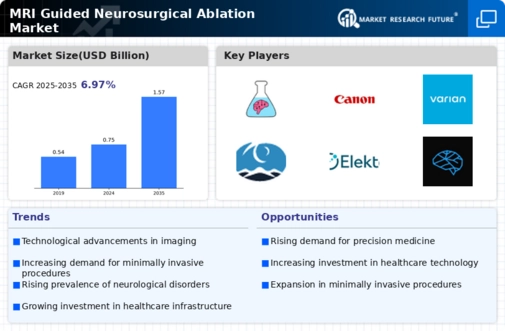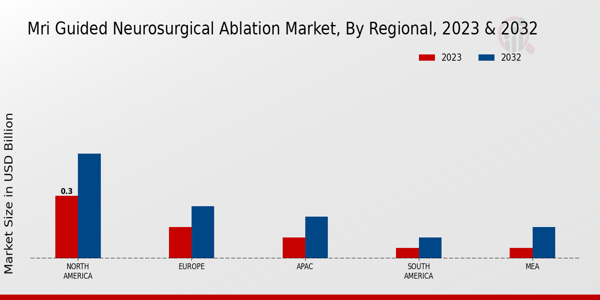Market Growth Projections
The Global MRI Guided Neurosurgical Ablation Market Industry is poised for substantial growth, with projections indicating a rise from 0.75 USD Billion in 2024 to 1.57 USD Billion by 2035. This growth trajectory reflects a compound annual growth rate (CAGR) of 6.96% for the period between 2025 and 2035. Various factors contribute to this optimistic outlook, including technological advancements, increasing prevalence of neurological disorders, and a shift towards minimally invasive procedures. As the market evolves, it is likely to attract further investment and innovation, solidifying its position as a critical component of modern neurosurgical practices.
Technological Advancements in MRI Systems
The Global MRI Guided Neurosurgical Ablation Market Industry is experiencing a surge due to rapid technological advancements in MRI systems. Enhanced imaging capabilities, such as higher resolution and faster scanning times, improve the accuracy of neurosurgical procedures. Innovations like functional MRI and diffusion tensor imaging allow for better visualization of brain structures, which is crucial for successful ablation. As of 2024, the market is valued at approximately 0.75 USD Billion, indicating a growing reliance on advanced imaging technologies in neurosurgery. These advancements not only enhance surgical outcomes but also contribute to the overall growth of the market.
Regulatory Support and Reimbursement Policies
Supportive regulatory frameworks and favorable reimbursement policies are vital drivers for the Global MRI Guided Neurosurgical Ablation Market Industry. Governments are increasingly recognizing the importance of innovative medical technologies and are establishing guidelines that facilitate their adoption. Additionally, reimbursement policies that cover MRI-guided procedures encourage healthcare providers to offer these services. This supportive environment is expected to contribute to market growth, with projections indicating an increase from 0.75 USD Billion in 2024 to 1.57 USD Billion by 2035. The CAGR of 6.96% from 2025 to 2035 suggests that regulatory and financial incentives will play a significant role in the expansion of this market.
Rising Investment in Healthcare Infrastructure
Investment in healthcare infrastructure is a crucial factor driving the Global MRI Guided Neurosurgical Ablation Market Industry. Governments and private entities are increasingly allocating funds towards advanced medical technologies and facilities. This investment enhances the availability of MRI-guided systems in hospitals and surgical centers, facilitating better access to neurosurgical treatments. As healthcare systems evolve, the integration of cutting-edge technologies becomes essential for improving patient outcomes. The anticipated growth of the market, from 0.75 USD Billion in 2024 to 1.57 USD Billion by 2035, is indicative of the positive impact that enhanced healthcare infrastructure has on the adoption of MRI-guided neurosurgical techniques.
Increasing Prevalence of Neurological Disorders
The rising incidence of neurological disorders globally is a significant driver for the Global MRI Guided Neurosurgical Ablation Market Industry. Conditions such as epilepsy, tumors, and chronic pain are becoming more prevalent, necessitating effective treatment options. The demand for minimally invasive procedures, like MRI-guided ablation, is increasing as patients seek alternatives to traditional surgery. This trend is expected to propel the market, with projections indicating a growth from 0.75 USD Billion in 2024 to 1.57 USD Billion by 2035. The CAGR of 6.96% from 2025 to 2035 underscores the urgency for innovative solutions in addressing these health challenges.
Growing Demand for Minimally Invasive Procedures
There is a notable shift towards minimally invasive surgical techniques within the Global MRI Guided Neurosurgical Ablation Market Industry. Patients and healthcare providers are increasingly favoring procedures that reduce recovery time and minimize complications. MRI-guided ablation offers precise targeting of affected tissues, which aligns with the trend towards less invasive interventions. This growing preference is reflected in the market's projected growth, with an anticipated increase from 0.75 USD Billion in 2024 to 1.57 USD Billion by 2035. The CAGR of 6.96% for the period from 2025 to 2035 indicates a robust future for minimally invasive neurosurgical options.












